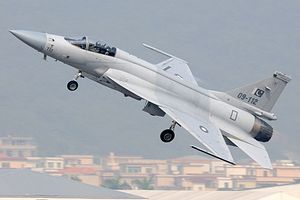The chief of air staff of the Pakistan Air Force (PAF), Air Chief Marshall Sohail Aman, offered the possible sale of Pakistan Aeronautical Complex/Chengdu Aerospace Corporation (PAC/CAC) JF-17 Thunder fighter jets and PAC Super Mushshak trainer aircraft to his Kuwaiti counterpart, Major General Abdullah Yaqoob Al-Fodri, during a four day visit to Kuwait last week.
Up until now, Pakistan has failed to secure a large export contract for its first domestically developed and produced combat aircraft. Despite good military-to-military relations between Pakistan and Kuwait—among other things, Kuwaiti pilots train in Pakistan—prospects for a sale are slim given that Kuwait recently ordered 28 Eurofighter Typhoons fighter jets for an estimated $9 billion.
Pakistan, however, could still succeed in pitching the JF-17B two-seat trainer variant to Kuwait for lead-in-fighter training. As I reported previously (See: “Two-Seat Variant of China-Pakistan JF-17 Fighter Jet to Fly in 2016”), Islamabad is expecting the maiden flight of the two-seat JF-17B variant to take place by the end of this year. The PAF plans to officially induct the first JF-17B lead-in-fighter trainer (LIFT) aircraft in April 2017.
Pakistan produced a total number of 16 JF-17 Thunder aircraft in 2015 and intends to increase production to 24 fighter aircraft in 2016. Pakistan produces 58 percent of the airframe and China 42 percent. The JF-17 is intended to replace the PAF’s fleet of Dassault Mirage III/5 fighter jets by 2o20. Overall, there are 65 JF-17 aircraft currently in service with the PAF.
“The JF-17 is a lightweight, single-engine, multirole combat aircraft, powered by a Russian-designed but Chinese-built Klimov RD-93 (RD-33 derivative) turbofan, capable of reaching a top speed of Mach 1.6. The fighter purportedly has an operational range of around 1,200 kilometers (745 miles),” I noted previously.
According to IHS Jane’s Defense Weekly, the JF-17 has “seven underwing/fuselage hardpoints, and is equipped with an internal GSh-23-2 twin-barrel cannon. Weapon options include up to four PL-5, -7, -8 or -9 short-range air-to-air missiles (AAMs) or four PL-12/SD-10B medium-range AAMs; two C-802A anti-ship missiles; two anti-radiation missiles; five 500 kg bombs; twin launchers for up to eight 250 kg, MK-20, GBU-12 or anti-runway bombs; single 1,000 kg bomb or GBU-10; or up to three mission pods.”
In comparison to the JF-17, Pakistan has had more success in exporting its MFI-17 Super Mushshak military training aircraft, a PAC licence-built variant of the Saab MFI-17 Supporter aircraft, and is close to scoring a major export order, according to IHS Jane’s Defense Weekly. Islamabad appears to be in the final stages of concluding a deal to export 52 Super Mushshak trainer aircraft to Turkey. Previous customers of the MFI-17 have included Iran, Iraq, Oman, and Saudi Arabia.

































